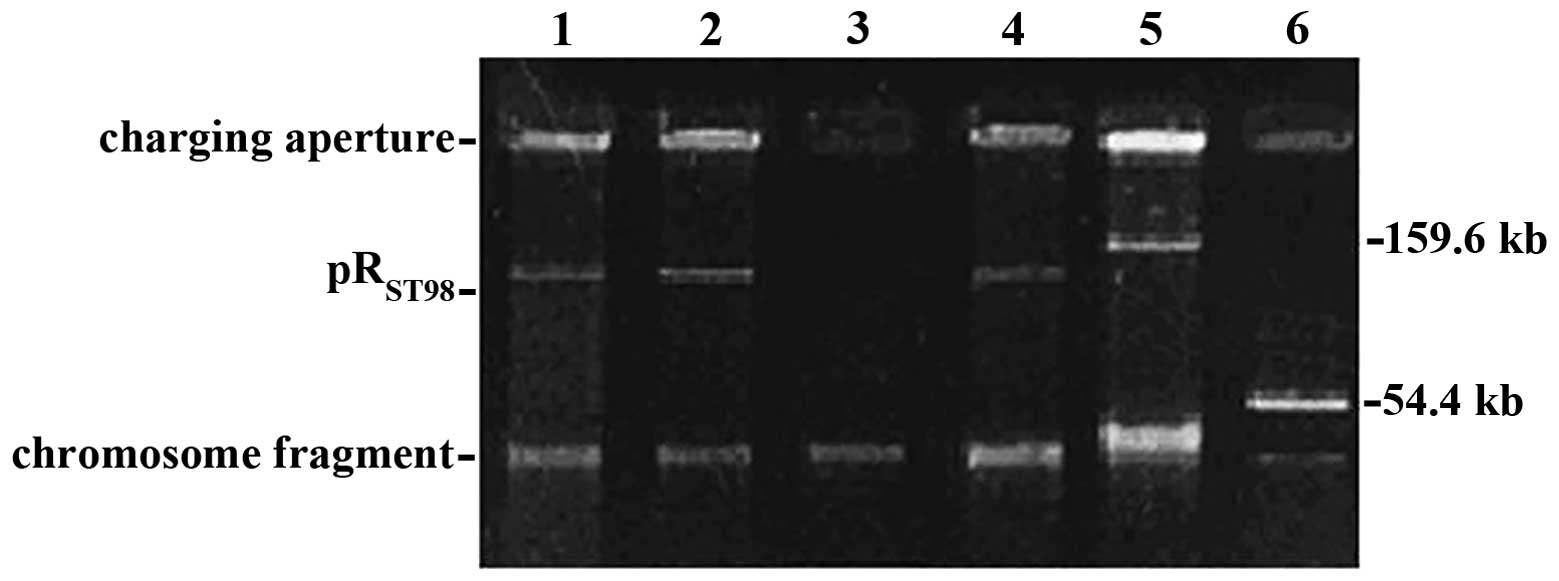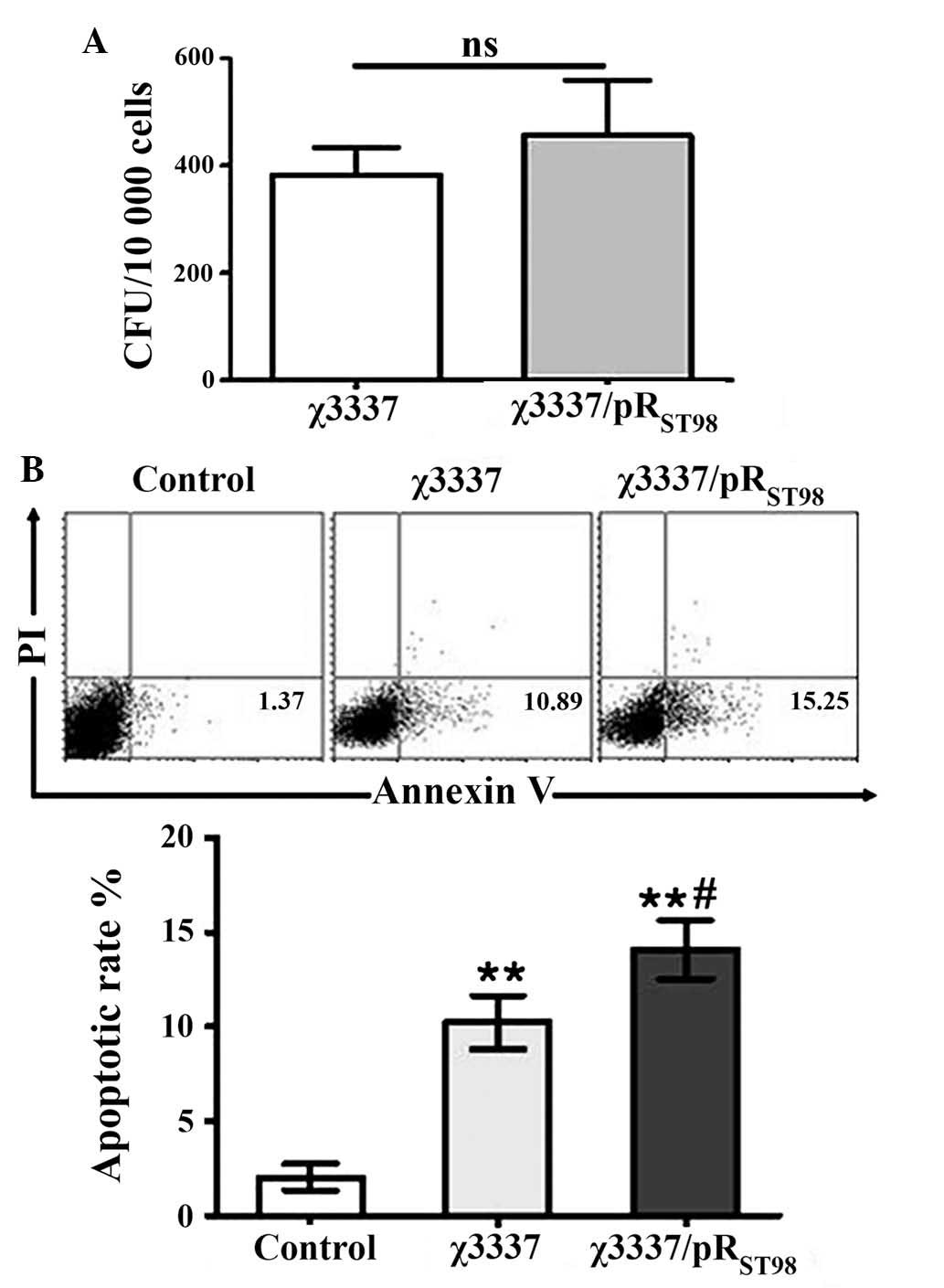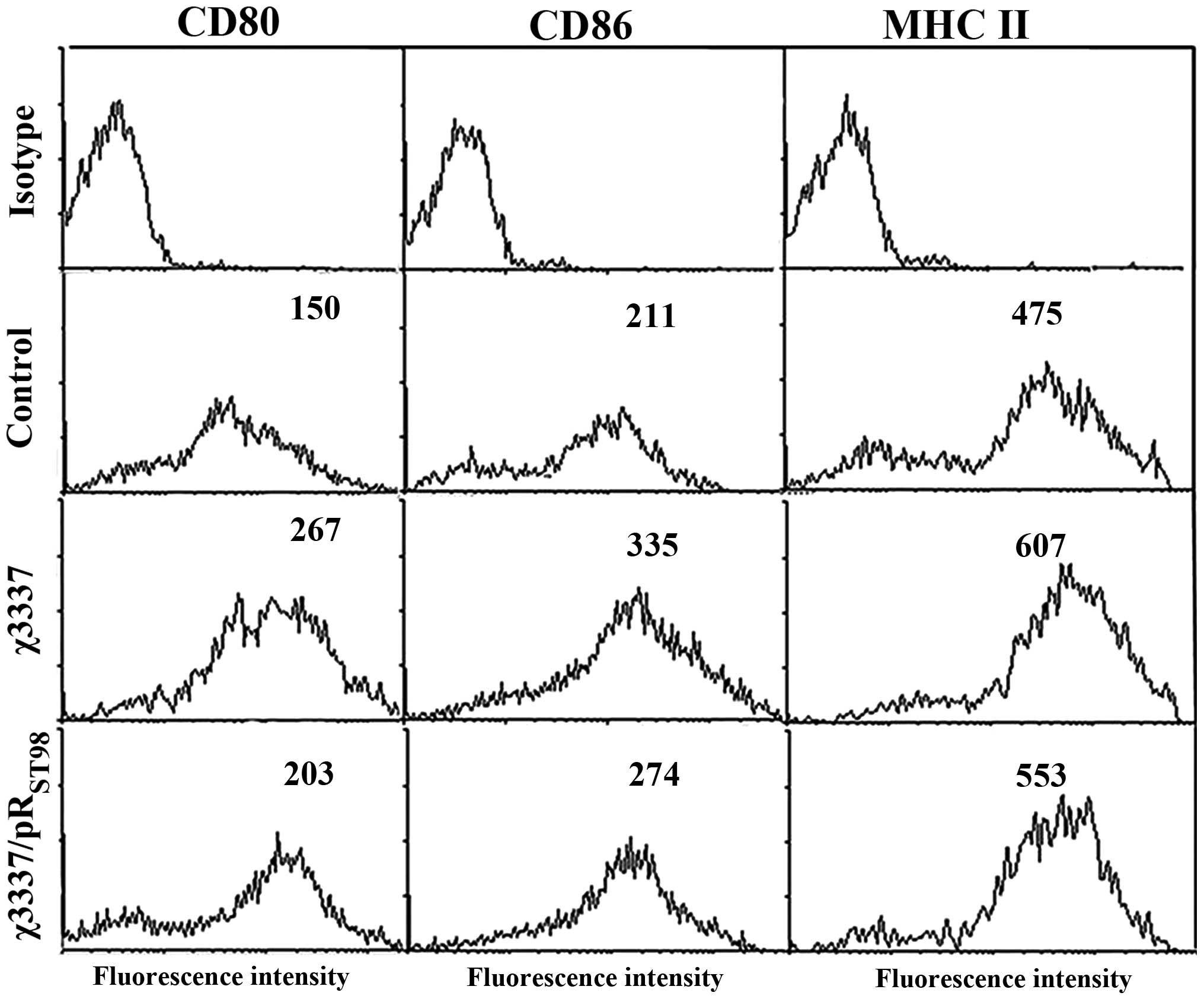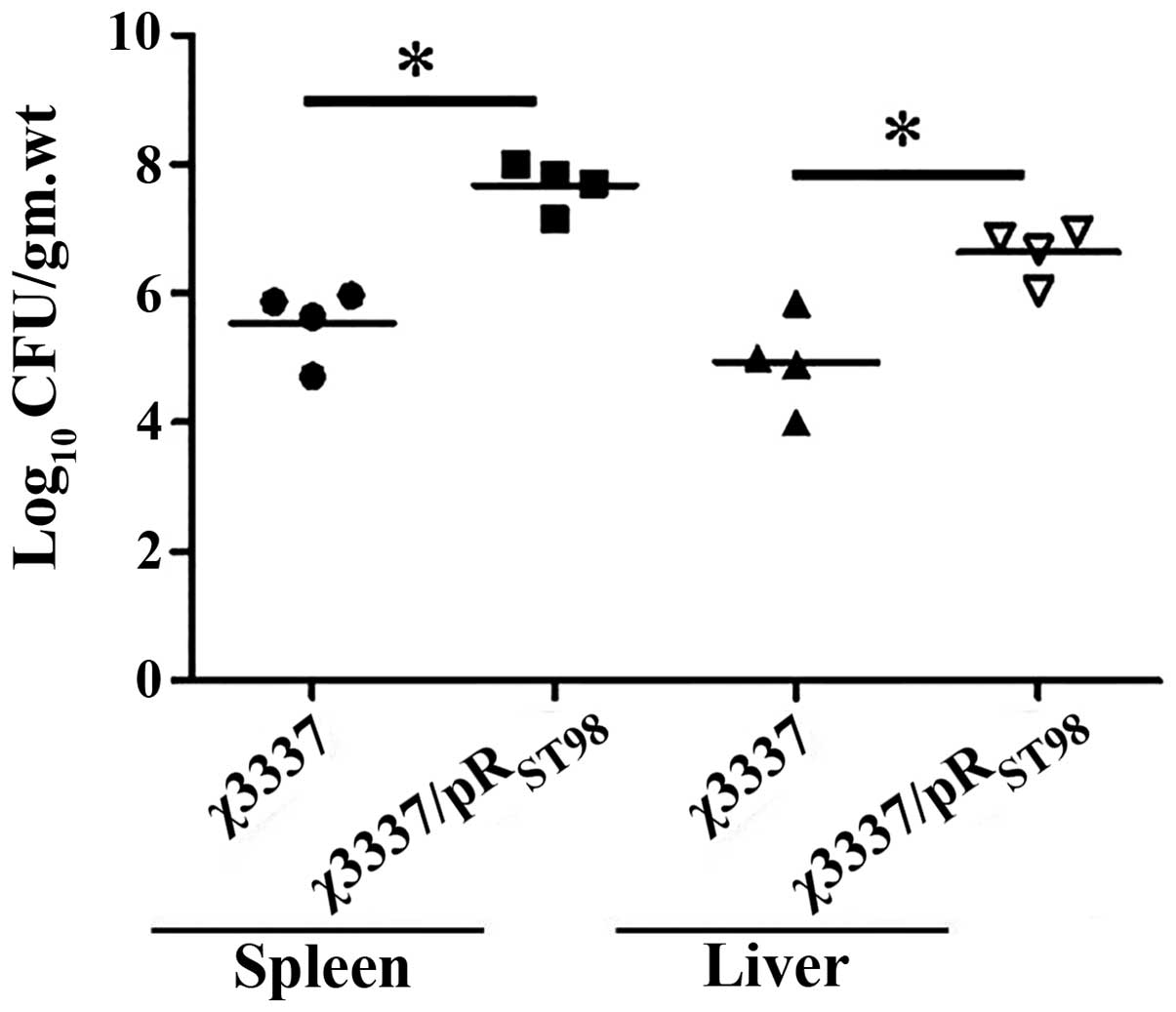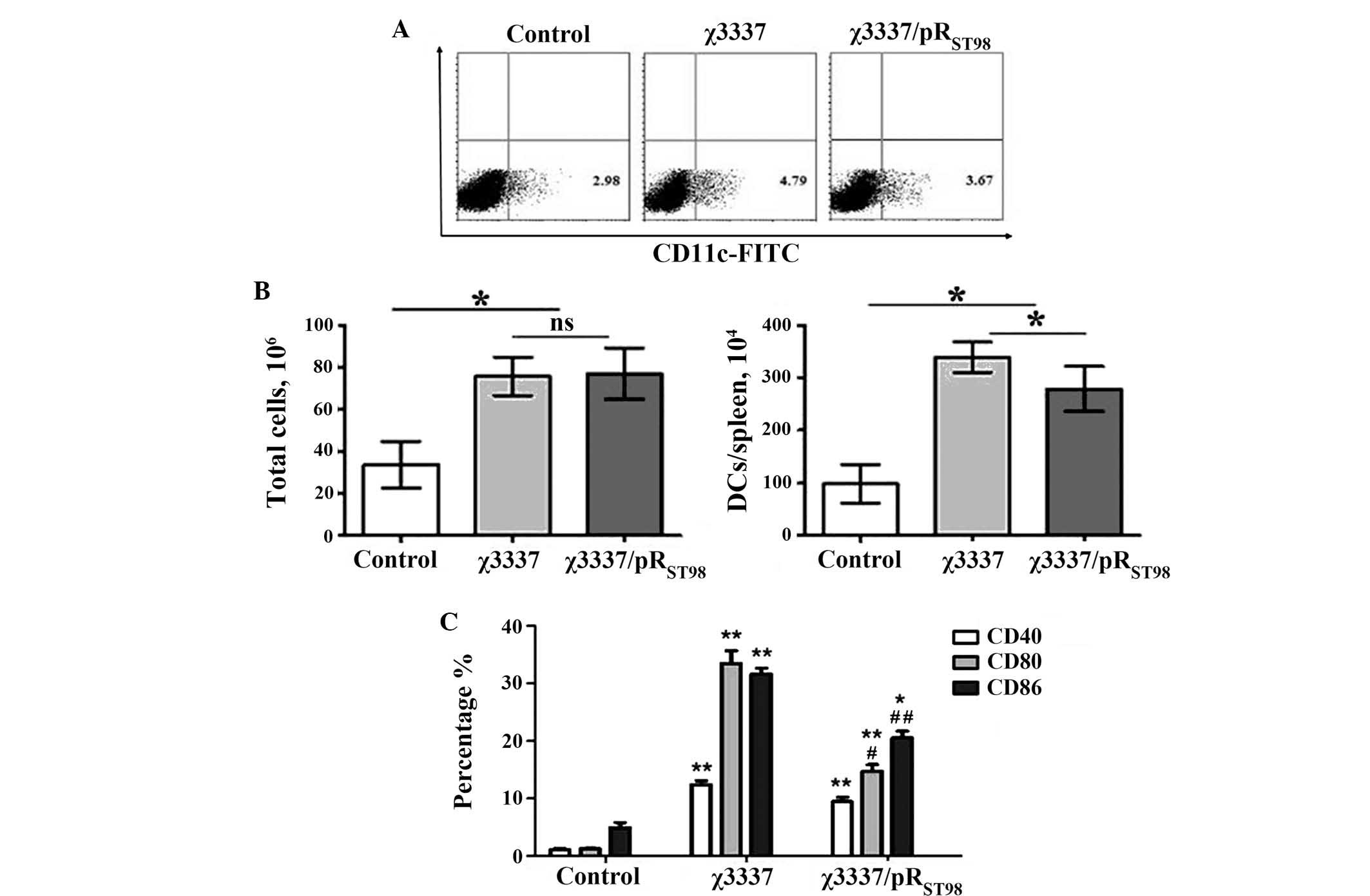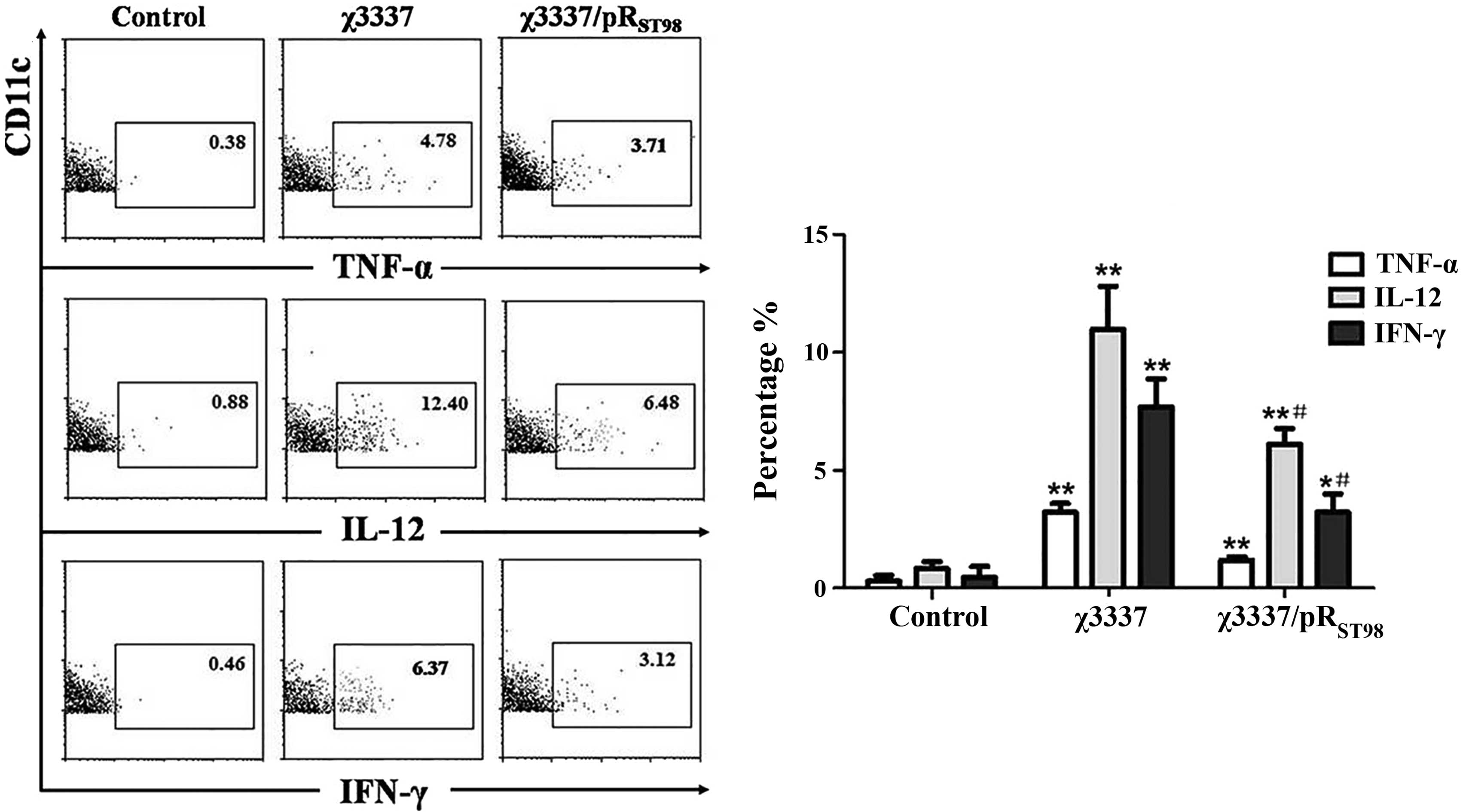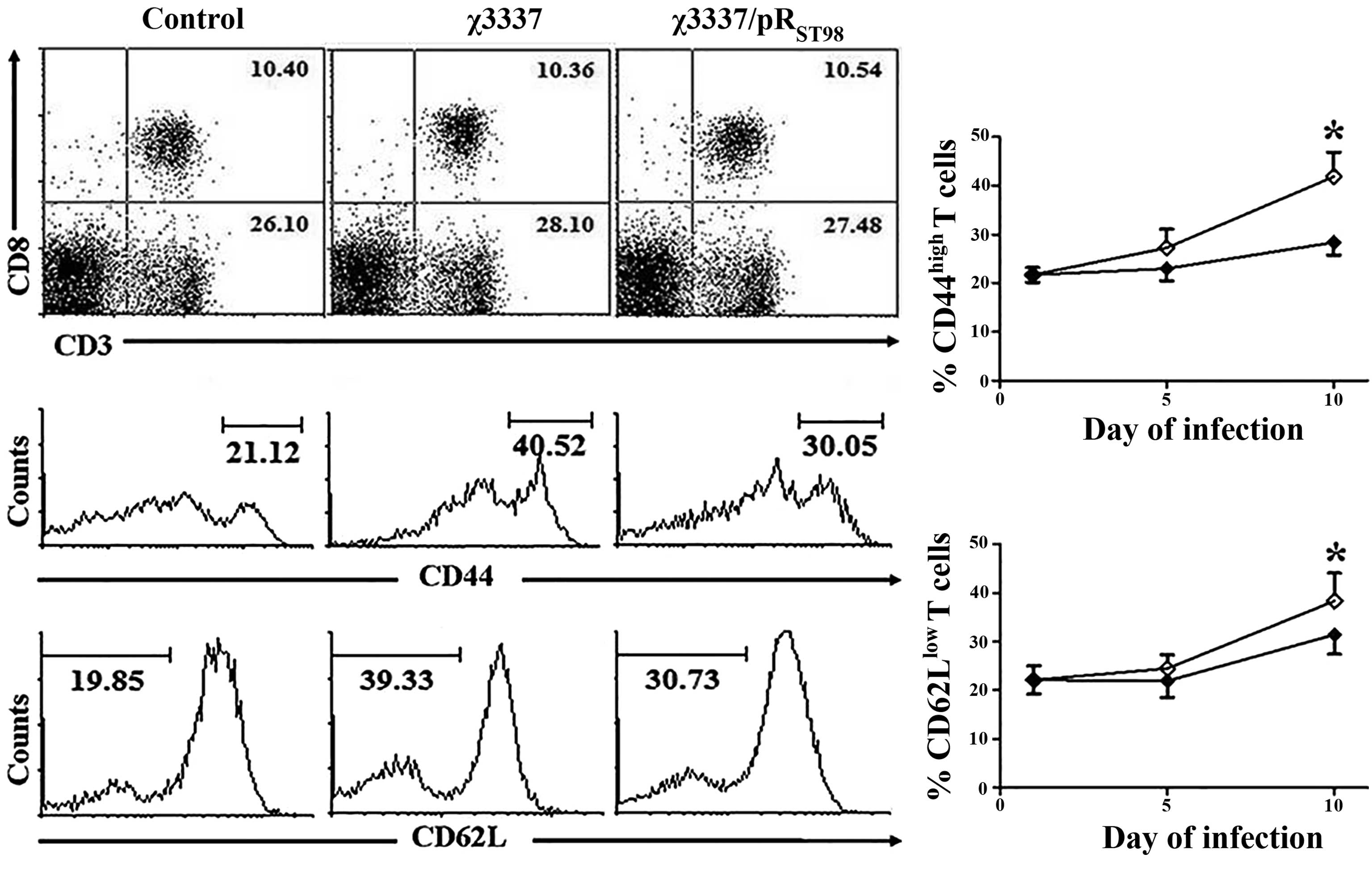Suppression of dendritic cell and T-cell activation by the pRST98 Salmonella plasmid
- Authors:
- Published online on: November 10, 2014 https://doi.org/10.3892/mmr.2014.2919
- Pages: 2306-2314
Abstract
Introduction
Immune surveillance by dendritic cells (DCs) is important in the mediation of innate and acquired immunity. To activate T lymphocytes following infection, DCs internalize and eliminate invading microbes and exhibit pathogen-derived antigens on their surface in the form of major histocompatibility complex (MHC) molecules (1,2). Salmonella is a facultative intracellular pathogen and the successful engagement of T lymphocytes is required for the initiation of protective immunity (3). The activity of pathogen-specific T cells significantly reduces the levels of infection and colonization by virulent bacteria, via direct elimination of bacteria or by enhancing the innate immune response. However, certain microbial pathogens have evolved molecular mechanisms aimed at interfering with DC activity in order to evade the specific adaptive immune response. These mechanisms are termed ‘immune evasion’ and significantly influence pathogen virulence (4,5).
The action of multiple pathogenic factors of Salmonella, encoded by the chromosome and the plasmid, is required during infection (6). The significance of large plasmids in determining the virulence of Salmonella has been the subject of numerous studies (7–9). In a previous study by our group, the 98.6 mDa, 150 kb Salmonella enterica serotype Typhi (S. Typhi) plasmid, designated as pRST98, was isolated during a survey of multidrug-resistant S. Typhi strains, and is known to mediate bacterial multidrug resistance to chloramphenicol, streptomycin, trimethoprin, sulphonamide, gentamicin, neomycin, kanamycin, cephalosporin, ampicillin, carbencillin and tetracycline. Patients infected with S. Typhi carrying pRST98 exhibited more severe symptoms and complications with high rates of mortality (10). However, only one plasmid existed in the isolates. It was therefore hypothesized that pRST98 may be a mosaic-like structure responsible for not only drug resistance, but also increased bacterial virulence.
On the plasmids of all pathogenic Salmonella spp., except S. Typhi, there is a highly conserved 8 kb region which encodes virulence phenotypes, and this gene is designated as the Salmonella plasmid virulence (spv) gene (11). The virulence genes on pRST98 were previously detected by spv-specific polymerase chain reaction and DNA analysis, and the results indicated that pRST98 shared 99.8% homology with spv (10). This study was the first, to the best of our knowledge, to reveal that spv homologous genes existed on the pRST98 plasmid. These early studies demonstrated that pRST98 enhanced the virulence of host bacteria by increasing survival and mediating macrophage apoptosis via the mitochondrial pathway (12). However, the phenotype remained of interest, since the mechanism of pRST98-increased bacterial virulence has remained to be elucidated.
The virulence of Salmonella is frequently serovar-specific, for example, S. Typhi causes typhoid fever in humans, but no disease is associated with S. Typhi infection of mice. In the present study, in order to determine whether pRST98 was involved in the specific immune response in vivo, pRST98 was transferred into S. Typhimurium χ3337 (a virulence plasmid-cured strain) and the conjugative strain χ3337/pRST98 was used in a murine salmonellosis model. The effect of pRST98 on important functions of murine DCs, including maturation as well as survival and cytokine production, was evaluated, as well as its effects on T cells. The results of the present study may aid the elucidation of the mechanism underlying S. Typhi immune evasion.
Materials and methods
Salmonella strains and growth conditions
In the present study, S. Typhimurium SR11 χ3337 (a nalidixic acid-resistant, virulence plasmid-cured derivative of χ3306) was used as a negative control. This strain was provided by Dr Roy Curtiss III (Arizona State University, Phoenix, AZ, USA). The multidrug-resistant S. Typhi strains harboring pRST98 were obtained from patients’ blood during a typhoid fever outbreak in Suzhou, China between 1987 and 1992. Plasmid-free Escherichia coli K12W1485 Rifr F-Lac(+) (E. coli K12W1485) with a rifampicin resistance gene on the chromosome and S. Typhimurium SR11 χ3337 were used as recipients to create the conjugant χ3337/pRST98. E. coli V517 (54.4, 7.3, 5.6, 5.2, 4.0, 3.0, 2.7 and 2.1 Kb) and Shigella flexneri 24570 (159.6, 4.0 and 3.0 Kb) harboring standard plasmids were used as size markers. All strains were grown to mid-logarithmic phase at 37°C in Luria-Bertani (LB) broth (Shanghai Kemin Biotechnology Co. Ltd., Shanghai, China) and quantified spectrophotometrically by determining optical density (OD) at 600 nm. Strains were subsequently centrifuged at 2,300 xg for 5 min and resuspended in RPMI-1640 medium (Gibco-BRL) without antibiotics prior to their addition to cells.
Conjugal transfer of pRST98 and electrophoretic analysis
The conjugal test was performed as follows: pRST98 was transferred from the clinical isolated multi-drug-resistant S. Typhi to a plasmid-free laboratory strain of E. coli K12W1485, and Shigella and Salmonella (SS) agar plates containing rifampicin (100 μg/ml) and chloramphenicol (20 μg/ml) (Beijing Biodee Biotechnology Co., Ltd., Beijing, China) were used. E. coli is able to ferment lactose, so that it can therefore be easily identified on an SS agar plate. pRST98 was transferred from E. coli K12W1485 to S. Typhimurium χ3337. E. coli K12W1485 receiving pRST98 (conjugant pRST98/E. coli K12W1485) was used as the donor, while S. Typhimurium χ3337 was the recipient. The two strains of bacteria were grown for 16 h at 37°C in LB broth and mixed well by transferring 0.1 ml of each into 3 ml fresh LB broth for 4 h at 37°C. The mixture was centrifuged at 2,300 xg for 5 min and resuspended in normal saline. 0.1 ml of the suspension was transferred to a casein hydrolysate agar plate and grown for 16 h at 37°C. The lawn was collected and the serial dilution tube test was conducted. 0.1 ml of the suspension was transferred to an SS agar plate containing rifampicin (100 μg/ml), chloramphenicol (20 μg/ml) and ampicillin (25 μg/ml) (Beijing Biodee Biotechnology Co., Ltd., Beijing, China). The colonies producing hydrogen sulfide were selected to be cultured a second time on the same selective agar, reactivated on LB agar plates and labeled as conjugant χ3337/pRST98. Plasmid DNA extraction and electrophoretic analysis were applied using routine methods (13).
Mice
BALB/c mice were purchased from the Experimental Animal Center (Chinese Academy of Science, Shanghai Laboratory Animal Center, Shanghai, China). Mice were housed in a pathogen-free animal facility and maintained under standard environmental conditions (room temperature 24±1°C; relative air humidity 50±2%; a 12-h light/dark cycle; fed standard rodent diet and water ad libitum). Mice were used aged 8–10 weeks (weight 30–40g) and animal experiments were performed following protocols approved by the institutional animal care and use committee of Bengbu Medical College.
Antibodies
Antibodies were obtained from eBioscience, Inc. (San Diego, CA, USA) unless otherwise stated. The fluorochrome-conjugated anti-mouse monoclonal antibodies (mAbs) used in the present study were as follows: anti-CD11c fluorescein isothiocyanate (FITC; N418), anti-MHC Class II(I-A) phycoerythrin (PE)-Cy5 (NIMR-4), anti-CD40 (PE; 1C10), anti-CD80 PE (16-10A1), anti-CD86 PE (PO3.1), anti-CD62L FITC (MEL-14), anti-CD44 PE (IM7), anti-CD3e peridinin chlorophyll (PerCP)-Cy5.5 (145-2C11), anti-CD8a allophycocyanin (APC) (53-6.7), anti-interleukin (IL)-12 PE (C 17.8), anti-interferon (IFN)-γ PE (XMG1.2), anti-tumor necrosis factor (TNF)-α PE (TN3-19) and all isotype-matched control mAbs were from Caltag Laboratories (Invitrogen Life Technologies, Carlsbad, CA, USA).
Cell culture and infection
For the generation of bone marrow-derived DCs, bone marrow was flushed from the tibias and femurs of 8 to 10-week-old mice. Following red cell lysis with lysing solution (BD Biosciences) and washing, the progenitor cells were cultured in six-well plates at 1×106/well in RPMI containing 10% fetal calf serum supplemented with 10 ng/ml recombinant mouse granulocyte-macrophage colony-stimulating factor (GM-CSF) and 10 ng/ml IL-4 (Biomics Biotechnology Co., Ltd., Nantong, China). These cells were cultured for six days at 37°C in 5% CO2, and fresh medium and cytokines were added on days two and four. On day six, the DCs were collected for use in the infection experiments.
For infection of DCs, 1.5×105 cells (invasion assays), 4×105 cells (apoptosis assays) or 106 cells (co-stimulatory molecule expression analysis) were seeded in 24- or six-well plates in medium without antibiotics and infected with the corresponding S. Typhimurium strains at a multiplicity of infection (MOI) of 20 bacteria per DC. Bacteria were centrifuged onto DC at 400 xg for 5 min. Following 1 h of infection, 100 μg/ml amikacin (AMK; Beijing Biodee Biotechnology Co.) was added to exterminate extracellular bacteria. Then, the cells were washed and further incubated with medium containing 10 μg/ml AMK to prevent extracellular growth of bacteria released from the infected DC for an additional, indicated length of time.
Bacterial invasion and DC viability assays
S. Typhimurium strains were grown to the mid-log growth phase, at which the bacteria are most invasive. DCs were infected in triplicate as aforementioned. To evaluate bacterial infectivity, AMK-treated DCs were permeabilized for 30 min with 0.1% Triton X-100 (Shanghai Fushen Biotechnology Co., Ltd., Shanghai, China) in phosphate-buffered saline (PBS; Hefei Bomei Biotechnology Co., Ltd., Hefei, China). Lysates of 2 h were plated on agar plates for overnight incubation at 37°C. At the same time-point, DC viability was analyzed using a FACSCalibur flow cytometer (BD Biosciences), using staining of fragmented DNA with propidium iodide and labeling of cells with fluorescently tagged Annexin V (BD Biosciences), which binds to phosphatidylserine present in the outer membrane of cells during early-stage apoptosis.
Detection of cell-surface markers
The infected cells were harvested at 24 h post-infection and incubated with mouse anti-FcRII/III mAb for 10 min at 4°C. Fluorochrome-conjugated antibodies were added to cells, which were incubated on ice for 30 min and then washed twice with wash buffer. Cells were kept on ice and analyzed by flow cytometry and CellQuest™ version 3.3 software (BD Biosciences, Franklin Lakes, NJ, USA) and WinMDI 2.8 (winmdi.software.informer.com/2.8/).
Bacterial infection of mice
S. Typhimurium strains were grown overnight in LB medium, harvested in the logarithmic phase (OD600=0.8–1.0), washed once in PBS and resuspended in PBS with 15% glycerol (Hefei Bomei Biotechnology Co.). The cultures were stored in aliquots at −80°C. The bacterial titers were determined by plating serial dilutions on LB agar plates. For infection, aliquots were thawed and appropriately diluted in PBS. In experiments in which DC and T-cell activation were analyzed, mice were infected intravenously with 500 organisms and sacrificed by cervical dislocation on the fifth or tenth day following infection. In experiments in which the intracellular cytokines of splenic DCs were studied, mice were administered a single intravenous injection of 107 bacteria and sacrificed 24 h subsequently. Total splenocytes were subjected to flow-cytometric analysis.
Flow-cytometric analysis of spleen cells
Single-cell suspensions were obtained by passing spleens through stainless steel meshes followed by erythrocyte lysis. Cells (106) were incubated with anti-FcRII/III mAb to block unspecific antibody binding. Following 10 min of incubation, cells were stained with FITC-conjugated mouse anti-CD11c, PE-conjugated mouse anti-CD40, PE-conjugated mouse anti-CD80, PE-conjugated mouse anti-CD86, PerCP-Cy5.5-conjugated mouse anti-CD3e, APC-conjugated mouse anti-CD8a, FITC-conjugated mouse anti-CD62L and PE-conjugated mouse anti-CD44. Following 30 min on ice, cells were washed and analyzed.
Intracellular cytokine expression was analyzed in a splenocyte preparation that had been incubated for 5 h in the presence of GolgiPlug™ (brefeldin A solution, 10 μg/ml; BD Biosciences). Cells were then washed with PBS supplemented with 0.1% bovine serum albumin (Beijing Leigen Biotechnology Co., Ltd., Beijing, China) and were surface stained for CD11c to identify splenic DCs and for co-stimulatory molecules. Cells were subsequently fixed, permeabilized and stained with anti-IL-12 PE, anti-IFN-γ PE or anti-TNF-α PE using the cytofix/cytoperm kit (eBioscience, Inc.) according to the manufacturer’s instructions. Flow cytometry was performed on splenocytes from individual mice stimulated separately.
Assessment of bacterial burden
Single-cell suspensions were obtained from the spleens of infected mice in RPMI-1640. An aliquot of the suspension was lysed and evaluated to determine the number of viable bacteria. Colony-forming units (CFU) were determined by plating serial dilutions of tissue homogenates on LB agar plates.
Statistical analysis
Values are presented as the mean ± standard deviation. Data obtained from independent experiments were analyzed using Student’s t-test. P<0.05 was considered to indicate a statistically significant difference between values. The statistical software package SPSS 15.0 (SPSS, Inc., Chicago, IL, USA) was used for all data analyses.
Results
Conjugal transfer of plasmid pRST98
S. Typhi causes typhoid fever in humans only; therefore, S. Typhimurium was employed to infect mice in order to study the pathogenesis of pRST98 in vivo. pRST98 was initially transferred from the multi-drug-resistant S. Typhi to E. coli K12W1485 and then transferred from E. coli K12W1485 to S. Typhimurium χ3337 to create the conjugant χ3337/pRST98. Electrophoretic analysis indicated that an additional 150-Kb pRST98 plasmid was found in χ3337/pRST98, compared to the recipient χ3337, which confirmed that pRST98 was transferred into χ3337 (Fig. 1).
pRST98 does not influence bacterial invasion
To date the role of pRST98 in bacterial invasion has remained elusive. The invasion ability of S. Typhimurium strains with or without pRST98 was compared. The results demonstrated that S. Typhimurium χ3337 and conjugant χ3337/pRST98 were equally invasive (Fig. 2A). This therefore indicated that the expression of pRST98 did not increase the ability of the bacteria to invade DCs.
DC viability is decreased following infection with pRST98 S. Typhimurium
A previous study demonstrated that the infection of macrophages or DCs with S. Typhimurium expressing the type III secretion system resulted in early apoptosis (14). To assess whether pRST98 of S. Typhimurium induced mortality of murine DCs and whether this may be involved in mediating the ability of DCs to stimulate T cells, an apoptosis assay was performed using S. Typhimurium-infected murine DCs. As illustrated in Fig. 2B, S. Typhimurium induced apoptosis in murine DCs. Two hours after infection, S. Typhimurium χ3337/pRST98-infected DCs exhibited a higher rate of apoptosis than that of χ3337-infected cells. Therefore, pRST98 may be an important factor involved in Salmonella-induced cell death.
S. Typhimurium induces DC maturation
To study the effects of Salmonella pRST98 on DC maturation, cells were infected with the corresponding bacterial strains, and the expression of co-stimulatory molecules involved in T-cell activation was measured by flow cytometric analysis following 24 h of further incubation to facilitate the biosynthesis of novel surface molecules. Unstimulated DCs are physiologically immature; however, following infection with S. Typhimurium χ3337 or χ3337/pRST98, DCs exhibited a mature phenotype, manifested as an increase in the expression of co-stimulatory molecules. Phenotypic changes following the infection of DCs with corresponding strains are indicated in Fig. 3. Compared to S. Typhimurium χ3337/pRST98- and χ3337-infected DCs exhibited increased expression levels of all three surface molecules (CD80, CD86 and MHC II), indicated by increased fluorescence intensity.
pRST98 enhances bacterial burden following S. Typhimurium infection
BALB/c mice were intravenously infected with 500 bacteria of corresponding S. Typhimurium strains. Infection resulted in massive expansion of bacteria in the spleen and liver. The two bacterial strains exhibited the same course. The number of bacteria recovered from χ3337/pRST98-infected mice was significantly higher than that of χ3337-infected mice ten days post-infection (Fig. 4). As expected, the χ3337/pRST98 strain was virulence-enhanced compared to the χ3337 strain, and the titer in the spleen and liver was 107 bacteria/organ.
Suboptimal activation of DCs results from infection with the conjugant, χ3337/pRST98
In vivo, Salmonella is usually contained within splenic DCs, which are the most efficient antigen-presenting cell (APC) types capable of stimulating naïve T cells (15). The present study therefore aimed to determine how the numbers and activation states of splenic DCs were altered during infection with S. Typhimurium. It was demonstrated that the overall number of splenic DCs increased significantly five days following infection with either strain, compared to that of mock-infected animals. A significant difference in the number of DCs in the spleen was observed between χ3337- and χ3337/pRST98-inoculated mice (Fig. 5A and B). To determine whether DC activation was distinct following wild-type χ3337 or the conjugant χ3337/pRST98 infection, cell surface expression of co-stimulatory molecules (CD40, CD80 and CD86) on CD11c(+) splenic DCs, as well as their ability to secrete the pro-inflammatory cytokines, was analyzed. Fig. 5C indicates that the extent of CD40, CD80 and CD86 upregulation is distinct following χ3337 infection, compared to that following χ3337/pRST98 immunization. S. Typhimurium χ3337 infection induced greater co-stimulatory molecule expression than χ3337/pRST98 immunization five days post-infection.
Furthermore, it was investigated whether the level of T-cell function induced by splenic DCs was correlated with the relative cytokine levels produced by these cells. As shown in Fig. 6, CD11c(+) splenic DCs from mice injected with S. Typhimurium produced IL-12, IFN-γ or TNF-α 24 h following infection without in vitro restimulation. The percentage of IL-12- or IFN-γ-producing splenic DCs in the mice infected with χ3337/pRST98 was significantly lower than that of those infected with χ3337. No significant difference was detected in the percentage of splenic TNF-α-producing DCs of mice infected with χ3337/pRST98 compared to that of χ3337-infected mice.
S. Typhimurium infection decreases T-cell activation
S. Typhimurium infection induced massive splenomegaly. On the tenth day post-infection, there was an almost three-fold increase in spleen cellularity. Total splenocytes were isolated from the naïve mice and mice infected with χ3337 or the conjugant χ3337/pRST98 at the fifth and tenth day post-infection and stained with specific antibodies. The effect of pRST98 on the status of the CD4(+) and CD8(+) T-lymphocyte populations was determined. The mice infected with either strain of S. Typhimurium did not demonstrate a significant change in T-cell population compared to that in the control mice. T lymphocytes were subsequently further analyzed for the expression of the immune activators CD44 and CD62L. In the immune system, CD62L is expressed on naïve T cells, but its expression declines upon activation. By contrast, the expression of CD44 is upregulated following activation of naïve T lymphocytes during their response against invading microbes (16). The mice were kept under pathogen-free conditions; however, it was observed that in naïve mice ~20% of splenic T cells exhibited a CD44(high) and CD62L(low) (activated) phenotype. Following infection with S. Typhimurium, expression of CD44 and CD62L on T cells was markedly altered (Fig. 7). ~30–40% of T cells acquired a CD44(high) and CD62L(low) phenotype at ten days post-infection. Although no significant difference was observed in the CD44(high) and CD62L(low) T-lymphocyte population in the χ3337-infected mice at five days post-infection, there was a <10% increase in this population at ten days post-infection compared to that in the χ3337/pRST98-infected mice. These results therefore suggested that pRST98 did not affect the status of the T-lymphocyte population, but prevented T-cell activation.
Discussion
The role of DCs in triggering anti-microbial immunity, particularly in vivo, has been well defined. S. Typhimurium is a bacterial pathogen that systemically disseminates from the site of infection (17). Studies have demonstrated that S. Typhimurium interferes with the activation of host adaptive immunity at multiple levels (18–20). Salmonella virulence factors perturb antigen processing and presentation by DCs, as well as the activation of Salmonella-specific T cells (21). These observations led to the hypothesis that this feature of virulent Salmonella is required to promote systemic dissemination in the host.
In previous studies by our group, it was demonstrated that plasmid pRST98 enhanced the virulence of host bacteria by increasing survival and mediating macrophage apoptosis via the mitochondrial pathway (12). Consistent with these results, pRST98 was found to influence multiple important functions of murine DCs, including maturation, survival and cytokine production. In addition, pRST98 was also demonstrated to decrease T-cell activation. These results suggested that by targeting the aforementioned functions of DCs, pRST98 may at least partially abrogate the adaptive immune defense mechanisms of the host, which are required for the elimination of the pathogen from infected tissues. However, further studies are required in order to determine the impact of pRST98 on subsets of splenic DCs.
Previous studies by our group suggested that pRST98 was not required for the invasion of non-phagocytic cells, including HeLa and Hep-2 cells (unpublished observations), but instead, its function was required to prevent significant entrance of Salmonella to phagocytic DCs. In the present study, pRST98 activity was demonstrated not to differentially modulate the entry of Salmonella to DCs. Sundquist and Wick (22) reported that the death of DCs induced by Salmonella following infection may have a negative impact on the initiation of antibacterial immunity. However, besides macrophagy, DCs may also undergo cell death following interaction with pathogenic Salmonella, pRST98 may potentially be one of the factors mediating the induction of DC death. Furthermore, it was revealed that Salmonella stimulation of immature DCs resulted in their maturation to APCs, characterized by enhanced expression of cell surface antigens, including CD80, CD86 and MHC II. This phenotypic alteration was similar to the response observed when DCs were treated with lipopolysaccharides, a response which is associated with increased levels of co-stimulatory surface molecules (23). Furthermore, the conjugant χ3337/pRST98-treated DCs exhibited lower levels of activation and maturation than those of χ3337-treated DCs. These results provided evidence that pRST98, one of the pathogenic factors of Salmonella, impaired the functions of DCs, predominantly via the induction of apoptosis and concurrent suppression of maturation.
Following investigation of the virulence of pRST98 in DCs as well as macrophage cell lines, the virulence of the conjugant strain was evaluated in a murine model. To analyze the bacterial colonization in various organs, groups of BALB/c mice were intravenously infected with 500 CFU χ3337 or the conjugant χ3337/pRST98. The organ load of the χ3337-infected mice was significantly lower than that of the χ3337/pRST98-infected mice in spleen and liver on the tenth day post-infection. This suggested that pRST98 was essential for conferring Salmonella virulence. Furthermore, recent studies have shown that following intravenous infection of S. Typhimurium, >50% of bacteria that reach the spleen are located inside DCs (15). Therefore, the virulence capacity of S. Typhimurium to spread systemically into the host may be directly correlated with the bacterium’s ability to avoid antigen presentation by DCs, without the activation of specific T-cell immunity. Quantitative changes in DCs were also apparent in response to Salmonella infection and significantly increased DC numbers were observed five days after infection. This increase may be due to DC migration to the spleen during infection, which occurs as a result of the functions of the spleen in initiating specific immunity and as a site of Salmonella replication (15). A marked maturation response of the splenic DCs was observed following infection and supported the hypothesis that pRST98 hindered DC maturation without influencing the total splenic DC number during infection.
Local inflammatory responses by innate cells within infected tissues may also influence antigen presentation and T-cell activation (17). The capacity of DCs to produce TNF-α, IL-12 and IFN-γ during Salmonella infection was therefore examined. An increase in DCs producing TNF-α was detected among the splenic DCs of Salmonella-infected mice. However, the absolute number of splenic DCs producing TNF-α during the first day of infection was relatively low (~104). The relative lack of DCs producing TNF-α suggested that DCs may not make a significant contribution to the control of initial bacterial replication. However, TNF-α produced by DCs may induce local effects during Salmonella infection in order to coordinate the maturation and migration of DCs. In this way, DC-derived TNF-α may facilitate a link between the innate and adaptive immune responses.
The results of the present study also revealed pRST98-associated changes in DC cytokine secretion during Salmonella infection. In vivo production of IL-12 by DCs in response to intravenous administration of microbial stimuli is rapid and transient (24–26). Following 24 h of S. Typhimurium infection, a portion of DCs produced IL-12 without restimulation in vitro, which indicated that these DCs were likely involved in IL-12 production in vivo. These results were consistent with studies in which IL-12 production of liver CD11c(+) cells was analyzed by flow cytometry following stimulation with S. Typhimurium (27). IL-12 is an essential cytokine, which may provide protective immunity against Salmonella, as it is a key cytokine produced by APC to stimulate a Th1-directed response (28,29). Salmonella-specific T cells developing under the influence of IL-12 produce cytokines, including IFN-γ, that enhance the bactericidal capacity of phagocytes and facilitate microbial elimination (30,31). These observations suggested that pRST98 interference with DC function may prevent the activation of T-cell-mediated immunity against antigens derived from this pathogen.
The activation and differentiation status of T cells during the course of infection was subsequently evaluated. T cells had acquired an activated phenotype after one week of infection. An almost 10% decrease in the CD44(high) and CD62L(low) T-lymphocyte population was observed in the χ3337/pRST98 infected mice ten days post-infection when compared to that in the χ3337 infected mice. It was therefore suggested that underlying the ability of pRST98 to impair the functions of DCs, is the inhibition of protective T-cell responses in vivo. However, the genetic basis of pRST98 modulation of DCs and T-cell activation remains to be elucidated.
In conclusion, the characterization of the chimeric plasmid pRST98, isolated from S. Typhi, may be potentially important for elucidating the virulence mechanism of this pathogen. The results of the present study indicated that pRST98 was a potent pathogenic factor of Salmonella and prevented DC-mediated activation of T cells, predominantly by inhibiting DC maturation. These results also potentially have significance in the treatment and prevention of typhoid fever.
Acknowledgements
The present study was supported by the Natural Science Foundation of China (no. 30972768), the Natural Science Foundation of Jiangsu province (no. BK2011286), the Special Research Fund for the Doctoral Program of High Education (no. 20103201110009), the Qinglan Project of Jiangsu Province (no. SR13400211) the Provincial Project of Natural Science Research for Colleges and Universities of Anhui Province of China (no. KJ2013B142) and the Program for Scientific Innovation Research of College Graduates in Jiangsu Province (no. CX10B_042Z).
References
|
Steinman RM: Dendritic cells and the control of immunity: enhancing the efficiency of antigen presentation. Mt Sinai J Med. 68:160–166. 2001.PubMed/NCBI | |
|
Walseng E, Bakke O and Roche PA: Major histocompatibility complex class II-peptide complexes internalize using a clathrin- and dynamin-independent endocytosis pathway. J Biol Chem. 283:14717–14727. 2008. View Article : Google Scholar : PubMed/NCBI | |
|
Mittrücker HW and Kaufmann SH: Immune response to infection with Salmonella typhimurium in mice. J Leukoc Biol. 67:457–463. 2000.PubMed/NCBI | |
|
Bosio CM, Bielefeldt-Ohmann H and Belisle JT: Active suppression of the pulmonary immune response by Francisella tularensis Schu4. J Immunol. 178:4538–4547. 2007. View Article : Google Scholar : PubMed/NCBI | |
|
Lecours MP, Gottschalk M, Houde M, Lemire P, Fittipaldi N and Segura M: Critical role for Streptococcus suis cell wall modifications and suilysin in resistance to complement-dependent killing by dendritic cells. J Infect Dis. 204:919–929. 2011. View Article : Google Scholar : PubMed/NCBI | |
|
Madajczak G and Binek M: Influence of spv plasmid genes group in Salmonella Enteritidis virulence for chickens. I. Occurrence of spv plasmid genes group in Salmonella Enteritidis large virulence plasmid. Med Dosw Mikrobiol. 57:163–174. 2005.(In Polish). | |
|
García-Quintanilla M and Casadesús J: Virulence plasmid interchange between strains ATCC 14028, LT2, and SL1344 of Salmonella enterica serovar Typhimurium. Plasmid. 65:169–175. 2011. View Article : Google Scholar | |
|
García-Quintanilla M, Ramos-Morales F and Casadesús J: Conjugal transfer of the Salmonella enterica virulence plasmid in the mouse intestine. J Bacteriol. 190:1922–1927. 2008. View Article : Google Scholar : PubMed/NCBI | |
|
Sajid SU and Schwarz S: Plasmid fingerprinting and virulence gene detection among indigenous strains of Salmonella enterica serovar enteritidis. J Ayub Med Coll Abbottabad. 21:83–86. 2009.PubMed/NCBI | |
|
Huang R, Wu S, Zhang X and Zhang Y: Molecular analysis and identification of virulence gene on pR(ST98) from multi-drug resistant Salmonella Typhi. Cell Mol Immunol. 2:136–140. 2005.PubMed/NCBI | |
|
Kurita A, Gotoh H, Eguchi M, et al: Intracellular expression of the Salmonella plasmid virulence protein, SpvB, causes apoptotic cell death in eukaryotic cells. Microb Pathog. 35:43–48. 2003. View Article : Google Scholar : PubMed/NCBI | |
|
Wu S, Li Y, Xu Y, Li Q, Chu Y, Huang R and Qin Z: A Salmonella enterica serovar Typhi plasmid induces rapid and massive apoptosis in infected macrophages. Cell Mol Immunol. 7:271–278. 2010. View Article : Google Scholar : PubMed/NCBI | |
|
Takahashi S and Nagano Y: Rapid procedure for isolation of plasmid DNA and application to epidemiological analysis. J Clin Microbiol. 20:608–613. 1984.PubMed/NCBI | |
|
Cirillo DM, Valdivia RH, Monack DM and Falkow S: Macrophage-dependent induction of the Salmonella pathogenicity island 2 type III secretion system and its role in intracellular survival. Mol Microbiol. 30:175–188. 1998. View Article : Google Scholar : PubMed/NCBI | |
|
Yrlid U, Svensson M, Håkansson A, Chambers BJ, Ljunggren HG and Wick MJ: In vivo activation of dendritic cells and T cells during Salmonella enterica serovar Typhimurium infection. Infect Immun. 69:5726–5735. 2001. View Article : Google Scholar : PubMed/NCBI | |
|
Baaten BJ, Li CR and Bradley LM: Multifaceted regulation of T cells by CD44. Commun Integr Biol. 3:508–512. 2010. View Article : Google Scholar | |
|
Hurley D, McCusker MP, Fanning S and Martins M: Salmonella-host interactions - modulation of the host innate immune system. Front Immunol. 5:4812014. View Article : Google Scholar : PubMed/NCBI | |
|
Alaniz RC, Cummings LA, Bergman MA, Rassoulian-Barrett SL and Cookson BT: Salmonella Typhimurium coordinately regulates FliC location and reduces dendritic cell activation and antigen presentation to CD4+ T cells. J Immunol. 177:3983–3993. 2006. View Article : Google Scholar : PubMed/NCBI | |
|
Halici S, Zenk SF, Jantsch J and Hensel M: Functional analysis of the Salmonella pathogenicity island 2-mediated inhibition of antigen presentation in dendritic cells. Infect Immun. 76:4924–4933. 2008. View Article : Google Scholar : PubMed/NCBI | |
|
Srinivasan A, Nanton M, Griffin A and McSorley SJ: Culling of activated CD4 T cells during typhoid is driven by Salmonella virulence genes. J Immunol. 182:7838–7845. 2009. View Article : Google Scholar : PubMed/NCBI | |
|
Bueno SM, Riedel CA, Carreño LJ and Kalergis AM: Virulence mechanisms displayed by Salmonella to impair dendritic cell function. Curr Med Chem. 17:1156–1166. 2010. View Article : Google Scholar : PubMed/NCBI | |
|
Sundquist M and Wick MJ: Salmonella induces death of CD8alpha(+) dendritic cells but not CD11c(int) CD11b(+) inflammatory cells in vivo via MyD88 and TNFR1. J Leukoc Biol. 85:225–234. 2009. View Article : Google Scholar | |
|
Jiang HR, Muckersie E, Robertson M, Xu H, Liversidge J and Forrester JV: Secretion of interleukin-10 or interleukin-12 by LPS-activated dendritic cells is critically dependent on time of stimulus relative to initiation of purified DC culture. J Leukoc Biol. 72:978–985. 2002.PubMed/NCBI | |
|
Huang LY, Reis e Sousa C, Itoh Y, Inman J and Scott DE: IL-12 induction by a Th1-inducing adjuvant in vivo: dendritic cell subsets and regulation by IL-10. J Immunol. 167:1423–1430. 2001. View Article : Google Scholar : PubMed/NCBI | |
|
Jiao X, Lo-Man R, Guermonprez P, et al: Dendritic cells are host cells for mycobacteria in vivo that trigger innate and acquired immunity. J Immunol. 168:1294–1301. 2002. View Article : Google Scholar : PubMed/NCBI | |
|
Schulz O, Edwards AD, Schito M, Aliberti J, Manickasingham S, Sher A and Reis e Sousa C: CD40 triggering of heterodimeric IL-12 p70 production by dendritic cells in vivo requires a microbial priming signal. Immunity. 13:453–462. 2000. View Article : Google Scholar : PubMed/NCBI | |
|
Johansson C and Wick MJ: Liver dendritic cells present bacterial antigens and produce cytokines upon Salmonella encounter. J Immunol. 172:2496–2503. 2004. View Article : Google Scholar : PubMed/NCBI | |
|
Lehmann J, Springer S, Werner CE, et al: Immunity induced with a Salmonella enterica serovar Enteritidis live vaccine is regulated by Th1-cell-dependent cellular and humoral effector mechanisms in susceptible BALB/c mice. Vaccine. 24:4779–4793. 2006. View Article : Google Scholar : PubMed/NCBI | |
|
Yoon WS, Choi HJ and Park YK: Salmonella Typhimurium harboring plasmid expressing interleukin-12 induced attenuation of infection and protective immune responses. J Gen Appl Microbiol. 57:115–122. 2011. View Article : Google Scholar : PubMed/NCBI | |
|
John B, Rajagopal D, Pashine A, Rath S, George A and Bal V: Role of IL-12-independent and IL-12-dependent pathways in regulating generation of the IFN-gamma component of T cell responses to Salmonella Typhimurium. J Immunol. 169:2545–2552. 2002. View Article : Google Scholar : PubMed/NCBI | |
|
MacLennan C, Fieschi C, Lammas DA, et al: Interleukin (IL)-12 and IL-23 are key cytokines for immunity against Salmonella in humans. J Infect Dis. 190:1755–1757. 2004. View Article : Google Scholar : PubMed/NCBI |



